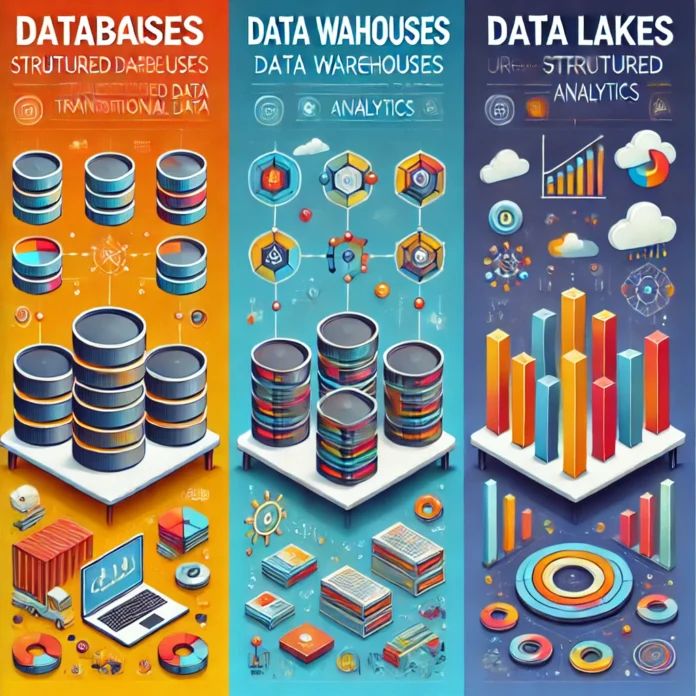In the rapidly evolving world of data management, organizations leverage different types of data storage solutions to meet various needs. Databases, data warehouses, and data lakes each serve distinct purposes and offer different capabilities, depending on how data is stored, processed, and analyzed. Understanding their unique characteristics is essential for building an efficient data architecture. Below is a detailed comparison of these three data storage solutions, highlighting their differences in terms of purpose, structure, performance, scalability, and more.
Purpose and Use Cases
- Database:
- Purpose: Databases are designed for real-time transactional data storage and management. They are used to support day-to-day operations, such as processing customer orders, managing inventories, or storing user profiles. Databases excel at online transaction processing (OLTP), where quick, real-time queries and updates are critical.
- Use Cases: Common use cases include banking systems, e-commerce platforms, and CRM systems, where operational data needs to be stored and accessed efficiently.
- Data Warehouse:
- Purpose: Data warehouses are optimized for historical data analysis. They store structured data that has been aggregated and transformed for reporting and business intelligence purposes. Data warehouses are ideal for online analytical processing (OLAP), where data is analyzed to inform business decisions.
- Use Cases: Typical use cases include generating business intelligence (BI) reports, performing trend analysis, and building operational dashboards for strategic decision-making.
- Data Lake:
- Purpose: Data lakes are designed to store large volumes of raw data in various formats (structured, semi-structured, and unstructured). They are used for big data analytics, machine learning, and data exploration. Data lakes do not require data to be pre-processed or organized before storage, making them a flexible solution for data from diverse sources.
- Use Cases: Common use cases include storing log files, sensor data, media files, and other raw data that can be processed and analyzed later for machine learning, data science, and advanced analytics.
Data Structure and Organization
- Database:
- Data Structure: Databases store structured data in a predefined schema, typically in a relational format (e.g., tables with rows and columns). The schema is strictly enforced, meaning the data must conform to the schema before it is stored. Databases follow a schema-on-write approach, where the structure of the data is defined before it is written to the database.
- Organization: Data is organized to support quick read/write operations for real-time transactional needs.
- Data Warehouse:
- Data Structure: Like databases, data warehouses store structured data, but the data is typically aggregated and transformed for analytical purposes. Data warehouses also use a schema-on-write approach, where data is processed and structured before it is loaded. However, data warehouses are optimized for querying large datasets for analysis rather than real-time operations.
- Organization: Data warehouses often use complex schema designs, such as star or snowflake schemas, to optimize queries across large datasets.
- Data Lake:
- Data Structure: Data lakes can store raw data in its native format, whether it’s structured, semi-structured (e.g., JSON, XML), or unstructured (e.g., text, images, videos). Unlike databases and data warehouses, data lakes do not enforce a schema when data is written, making them more flexible. They follow a schema-on-read approach, where the data’s structure is defined only when it is accessed for analysis.
- Organization: Data is stored as files or objects in distributed storage, often without predefined organization, allowing it to be processed as needed.
Performance and Querying
- Database:
- Performance: Databases are optimized for fast, transactional queries, such as reading and writing small amounts of data in real-time. They are built to handle high volumes of simple queries that require immediate responses, making them ideal for operational workloads.
- Querying: Databases support basic SQL queries for quick data retrieval, focusing on operational efficiency rather than deep analysis.
- Data Warehouse:
- Performance: Data warehouses are optimized for complex queries over large datasets. They are designed for batch processing and generating insights by running queries that aggregate, filter, and analyze historical data. These queries are often more resource-intensive than transactional queries in databases.
- Querying: Data warehouses support complex, multi-dimensional queries for business intelligence and analytics. They are ideal for creating dashboards, generating reports, and analyzing trends.
- Data Lake:
- Performance: Data lakes are not optimized for fast querying but are designed for large-scale data processing and analytics. Query performance can vary depending on the tools and technologies used (e.g., Apache Spark, Presto). Data lakes are more suited for data exploration, machine learning, and big data analytics than real-time queries.
- Querying: Querying data in a data lake often requires specialized tools that can handle large volumes of raw data. Data lakes are used for exploratory analysis rather than operational queries.
Storage and Scalability
- Database:
- Storage: Databases generally store smaller, operational datasets compared to data warehouses and data lakes. The storage is optimized for fast access to real-time data, which changes frequently.
- Scalability: Databases typically scale vertically (adding more resources to a single server) or horizontally (adding more database instances). They are designed to handle smaller, transactional workloads rather than large-scale analytics.
- Data Warehouse:
- Storage: Data warehouses store large volumes of processed and structured data. They are designed to handle massive datasets that are aggregated for analysis and reporting. Data warehouses typically store historical data from multiple sources for long-term analysis.
- Scalability: Data warehouses scale horizontally, especially in cloud-based environments, allowing them to handle large-scale analytics workloads. They are optimized for querying large datasets across distributed systems.
- Data Lake:
- Storage: Data lakes are built to store vast amounts of raw data, often in petabytes or exabytes. They rely on distributed storage systems (e.g., Hadoop Distributed File System, Amazon S3) that allow them to scale out by adding more storage nodes.
- Scalability: Data lakes are designed for horizontal scalability, making them suitable for storing and processing massive datasets from various sources.
Data Quality and Governance
- Database:
- Data Quality: Databases enforce strict data quality controls, ensuring that data is validated and conforms to predefined schemas before it is stored. This guarantees data consistency and reliability for real-time operations.
- Governance: Databases have strong governance and security measures, particularly for transactional data. They ensure data accuracy, integrity, and compliance through access controls and constraints.
- Data Warehouse:
- Data Quality: Data warehouses enforce high data quality standards through ETL (Extract, Transform, Load) processes, ensuring that data is cleaned, transformed, and standardized before being loaded into the warehouse. This ensures that the data is reliable and ready for analysis.
- Governance: Data warehouses offer robust data governance and security, with strict access controls and compliance measures, especially when dealing with sensitive, aggregated data used for decision-making.
- Data Lake:
- Data Quality: Data lakes store raw, unprocessed data, so they do not impose strict data quality controls. Ensuring data quality in a data lake often requires additional processing and transformation before the data can be used for analysis, which can be a challenge.
- Governance: Governance in data lakes can be complex due to the variety of data formats and sources. Data lakes require careful management to avoid becoming “data swamps,” where data is difficult to find, access, or trust. Security and access controls need to be implemented to ensure data governance.
Cost
- Database:
- Cost: Databases can be costly to operate, particularly as data volume and transactional throughput increase. Costs include licensing fees (for commercial databases), hardware, and operational expenses for maintaining high availability and performance.
- Storage Costs: Higher on a per-gigabyte basis compared to data lakes, as databases are optimized for fast access and transactional integrity.
- Data Warehouse:
- Cost: Data warehouses tend to be more expensive to operate due to the storage and compute resources needed for processing large datasets. However, modern cloud-based data warehouses often offer flexible pricing models (e.g., pay-per-query in Google BigQuery).
- Storage Costs: Higher overall, especially for storing and processing large volumes of structured data for analysis.
- Data Lake:
- Cost: Data lakes are generally more cost-effective for storing large volumes of raw data. They use cheaper storage solutions, such as cloud object storage (e.g., Amazon S3), but processing and analyzing data can incur additional costs depending on the tools and computing resources used.
- Storage Costs: Lower compared to databases and data warehouses, particularly for storing raw or infrequently accessed data.
Summary: Database vs. Data Warehouse vs. Data Lake
- Database:
- Designed for real-time transactional data (OLTP).
- Stores structured data in a predefined schema with schema-on-write.
- Optimized for fast read/write operations and simple queries.
- Smaller storage capacity, typically scaled vertically or horizontally for operational workloads.
- Strict data quality and governance controls.
- Data Warehouse:
- Designed for historical data analysis (OLAP).
- Stores structured, processed data in a schema with schema-on-write.
- Optimized for complex queries over large datasets for business intelligence and reporting.
- Large storage capacity for aggregated data, with horizontal scalability.
- High data quality standards and strong governance for reliable analytics.
- Data Lake:
- Designed for storing large volumes of raw data for big data analytics, machine learning, and data exploration.
- Stores raw data in various formats with schema-on-read.
- Optimized for large-scale data processing rather than real-time queries.
- Massive storage capacity with horizontal scalability.
- Flexible data storage, but requires careful governance to ensure data quality and accessibility.
In modern data architecture, many organizations use all three solutions in tandem. Databases manage operational data, data warehouses provide structured data for business intelligence, and data lakes store raw data for big data analytics and machine learning. This hybrid approach enables organizations to gain insights from their data across different use cases and applications.




